Various companies and brands are widely adopting omnichannel marketing. However, there are certain challenges of omnichannel marketing that seem to drag down different enterprises during the implementation stage.
Omnichannel refers to the use of different integrated modes to reach the end consumer seamlessly. This may include promoting your brand through various channels, such as messaging, chatbots, emails, phone calls, TV, radio, influencers, and other offline modes like posters or word of mouth.
However, it can be hard to balance all the different channels without a perfect marketing strategy. But don’t get it twisted with multichannel marketing. The ability to use all media seamlessly to provide a customized experience is what is referred to as omnichannel marketing.
Speaking with one voice.
The use of multiple media to reach consumers is termed multichannel marketing, whereas the seamless integration of all these media is known as omnichannel marketing.
| TL;DR (Generated by AI) Omnichannel marketing unifies all channels (online, offline, apps, social) to deliver a seamless, personalized customer experience. Key challenges include inconsistent messaging, lack of personalization, outdated data, poor content strategy, and difficulty measuring results. Solutions: integrate data systems, train teams, keep content and customer info up to date, and track the entire customer journey. Done right, it can drive much higher engagement and sales. |

- Step-by-step, SEO-driven guides
- Keyword-rich & easy to read
- Clear structure for better engagement
What are the Challenges of Omnichannel Marketing and How to Fix Them?
There are certain challenges of omnichannel marketing. These include
1. Inability to Create a Seamless Customer Journey
At times, integration may be complex, which can lead to a lack of a personalized experience if all the mediums are not interconnected.
For example, a website may have different information from the app.
If the technical and marketing teams don’t work hand in hand, things may not work as they should.

It will even be challenging to track how a customer obtained certain information that led to a specific inquiry or purchase. In some cases, competition from similar brands makes it hard to retain customers if they offer products at lower prices.
Also, if they have an easier mode of products reaching the consumers, it can be disadvantageous to some startup brands.
How to Fix This Omnichannel Marketing Challenge
Check your competitors and see what they are doing and you ain't. How are they engaging users on social media, websites, apps, chatbots, SMS, or other media?
Strive to have something similar.
Therefore, consumers will trust your brand if all the information provided on all your communication channels is interconnected.
2. Lack of a Personalized Experience
Some customers are used to personalized experiences based on their searches.
For example, through Netflix, people get recommendations based on their watch history, and through Amazon, you get recommendations based on your purchase history.

However, if your marketing strategies don’t provide a personalized experience, then it becomes hard to retain customers. For example, if someone doesn't get advertisement recommendations on Facebook or other channels based on what they prefer, they might never make any purchases on your platform.
Therefore, marketers must think like a customer.
If they love cooking, what other cooking items do you think can spark an interest in them? Some of the challenges of omnichannel can be solved with proper research and analytics. The purchase history of consumers can help.
How to Fix This Personalized Experience Omnichannel Marketing Challenge
Utilize the best analytics tools to analyze purchases made by users of different demographics so that you can get an overview of what they prefer.
If you have information on purchase history, it will be easier to deal with their different wants. This also requires assessing the success of your marketing campaigns one by one to see how to improve performance.
3. Poor Content Strategy
Content is crucial in any marketing strategy. Consumers use different media, such as your website, app, social media accounts, and other channels, to interact with your brand.
Therefore, they expect to find relevant information on the different channels.
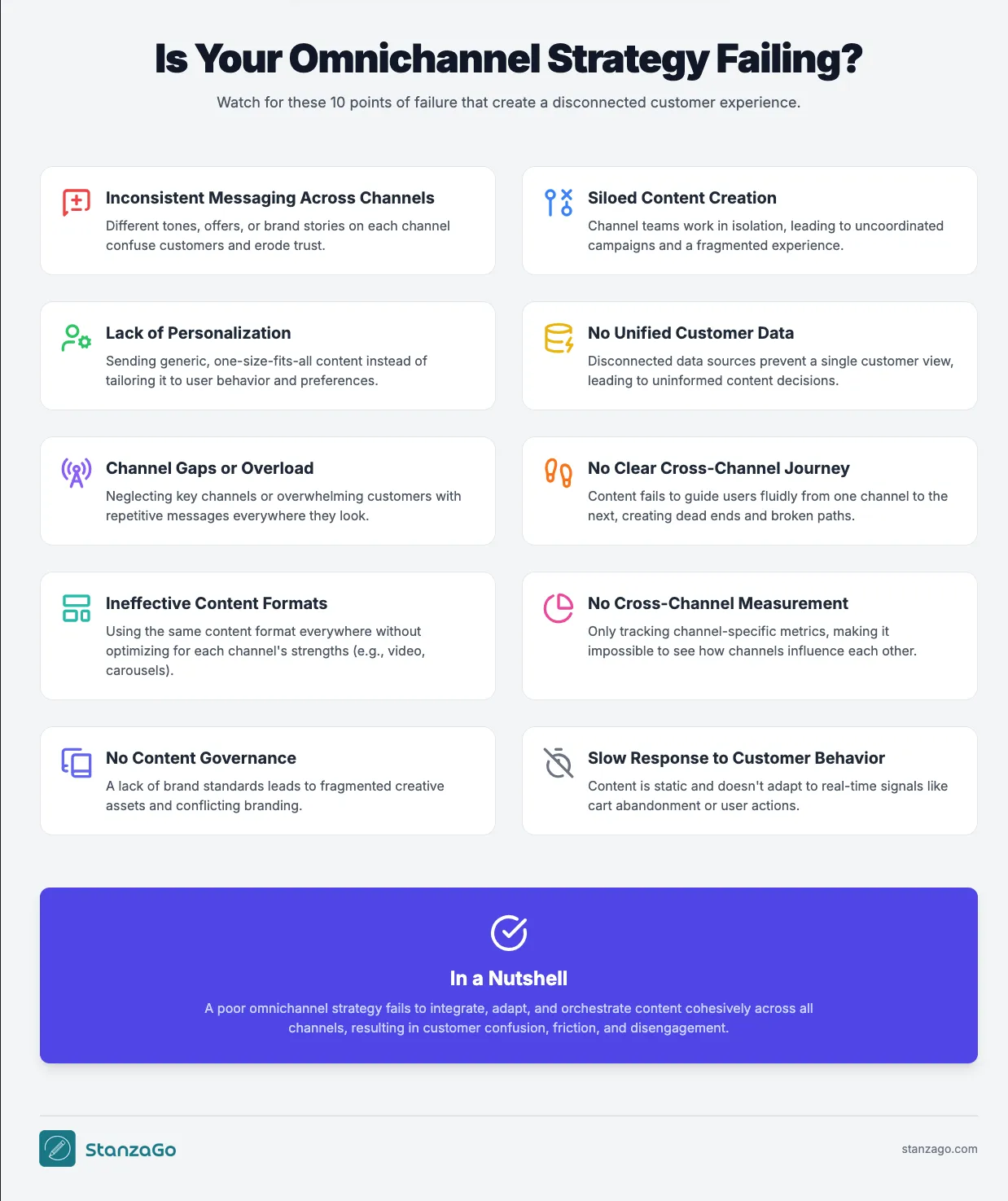
For example, if you decide to showcase special item discounts through your Instagram business page, a consumer will most likely access your website to see whether it is true.
However, if there is no update on the website about the same, the consumer may feel as if the company is using fake news to lure people to their website. This is one of the major challenges of omnichannel marketing.
How to Fix This Poor Content Strategy Challenge
Therefore, it is wiser to provide information on the app and website upfront before making any announcement on social media platforms. Also, provide valuable information on online platforms in real-time.
For example, if the physical store will be closed on certain days, ensure the information is on the website, app, social media platforms, and other media. Relevant content makes consumers ready to make purchases.
Therefore, more relevant content equates to more purchases. Also, having an email sign-up form can boost the capture of important data.
4. Lack of Update of User Data
People regularly change their email addresses, phone numbers, and other media.
However, if you don't keep that in mind, you might end up always sending information to the wrong personal details. Therefore, even when sending emails, they might not reach the intended person in real-time.
How to Fix This Omnichannel Marketing Challenge
You can always confirm customer details periodically.
You may even request that they update their customer email, phone number, and other information in real-time. Additionally, if there are any duplicate or incomplete data, you may request that the user complete it.
When information is stored in a unified system, it becomes easier to deliver relevant content.
5. Inability to Take Action on Insights
Insights are valuable for any business that wants to prosper.
However, if there is no specialized personnel who know how to capture and interpret the insights, that can be among the challenges of omnichannel marketing.
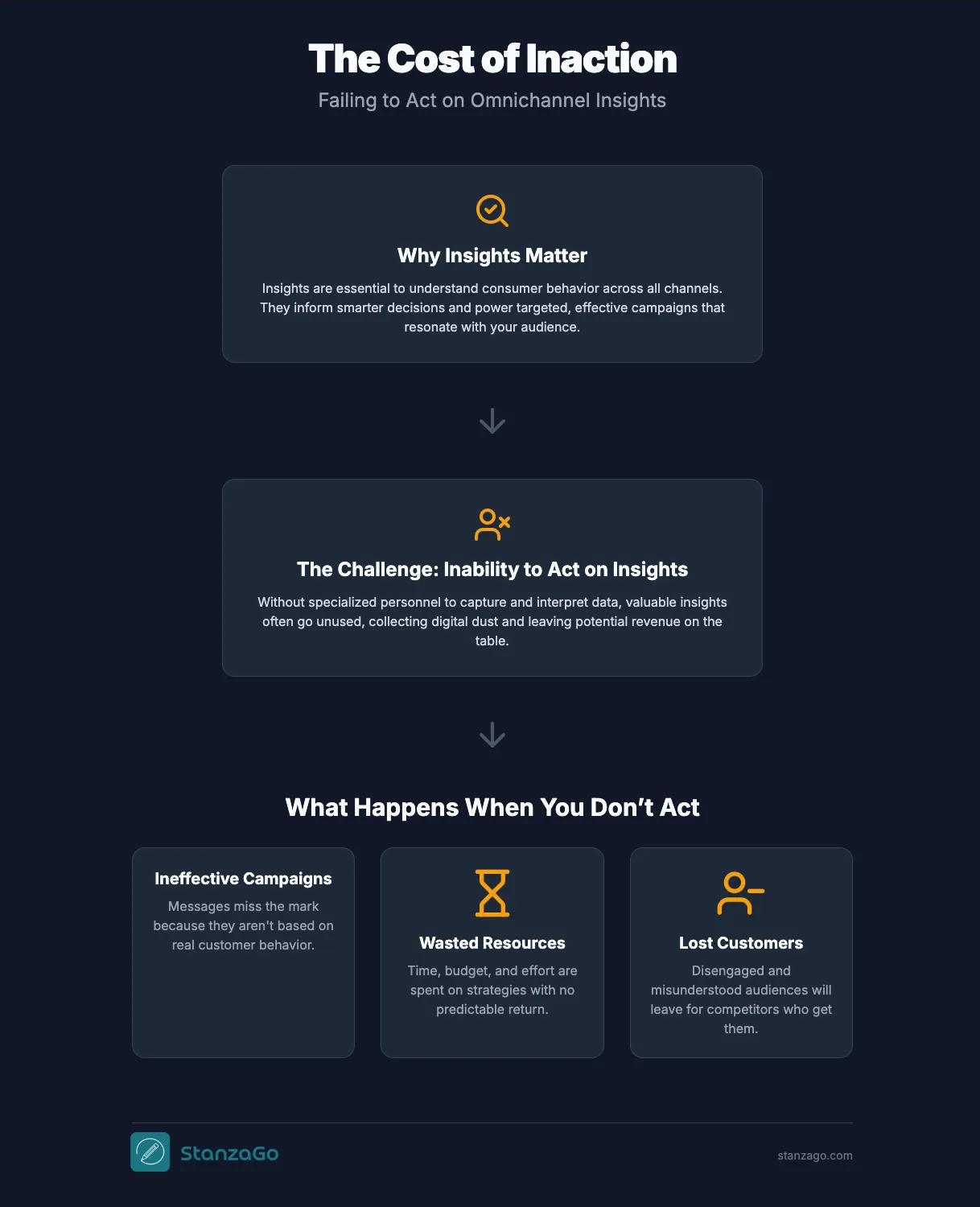
Proper interpretation of insights can help understand consumers' purchasing behavior. However, the lack of taking necessary steps on available data can lead to ineffective marketing campaigns.
How to Fix This Challenge of Omnichannel Marketing
It is important to have a professional who knows how to interpret certain insights and collect data. It is also wise to hire technical personnel who can use relevant technology to plan a better omnichannel marketing strategy.
This will prevent consumers from getting a disjointed experience from brands.
Also, it is crucial to test the success of the different advertisement campaigns to continue to acquire and retain the right customers.
6. Omnichannel Marketing Implementation Challenges
Some marketers tend not to be well-equipped on how to coordinate the various marketing channels.
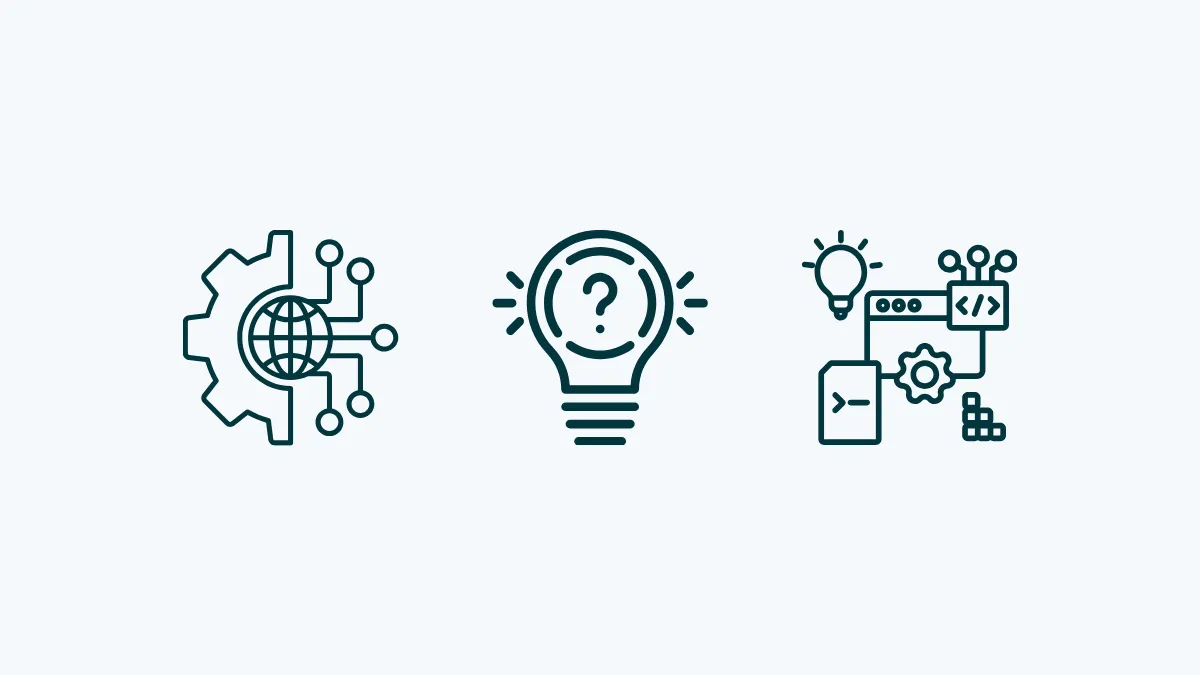
This makes it hard to coordinate the marketing campaign on the various channels. This is especially true when it comes to newly introduced channels that most marketing personnel don't know how to utilize.
How to Fix This Challenge
Proper training and information dissemination.
Regular training can help marketers know how best they can promote products or even reach their target audience in real-time.
This is achieved by first putting more effort into understanding the customers, the personalized experience they need, and segmenting the buyers. You can also have regular surveys that help you understand the buyers better.
Information is key in any marketing strategy.
7. Insufficient Measurement of Campaign Effectiveness
Omnichannel marketing requires the integration of different systems for a common good. However, if the campaigns are not measured as required, it may lead to the wrong strategies being put in place.
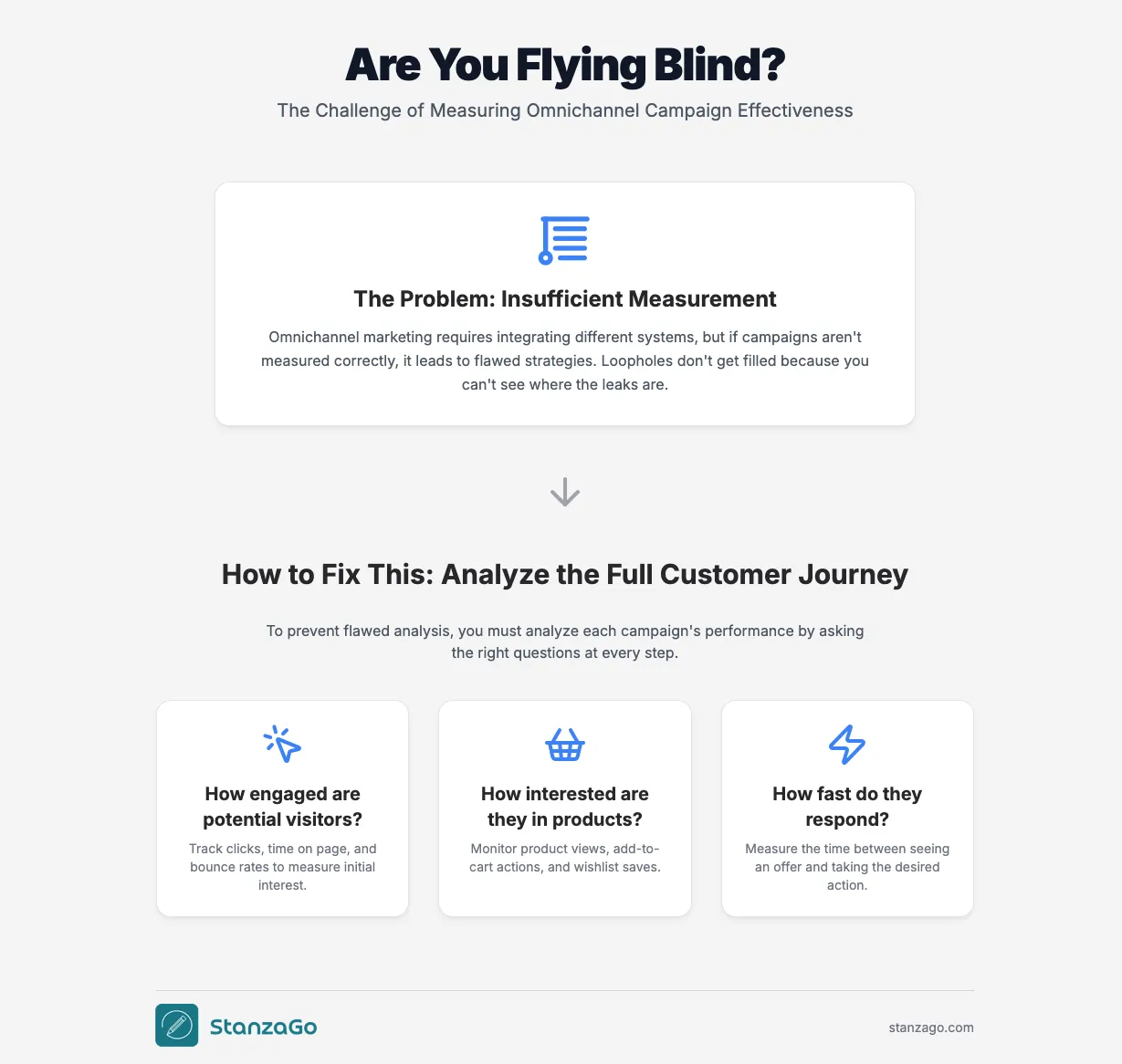
Therefore, the loopholes won’t be easily filled as they should be.
How to Fix This Omnichannel Marketing Challenge
To prevent wrong analysis of the progress, each of the campaigns used in the customer journey should be analyzed.
- How engaged are the potential website visitors?
- How interested are they in the products?
- How fast do they respond to certain information?
8. Not Understanding the Customer Journey
Another omnichannel marketing issue is not understanding the customer journey.
Through marketing, you want to understand how different customers came to your platform.
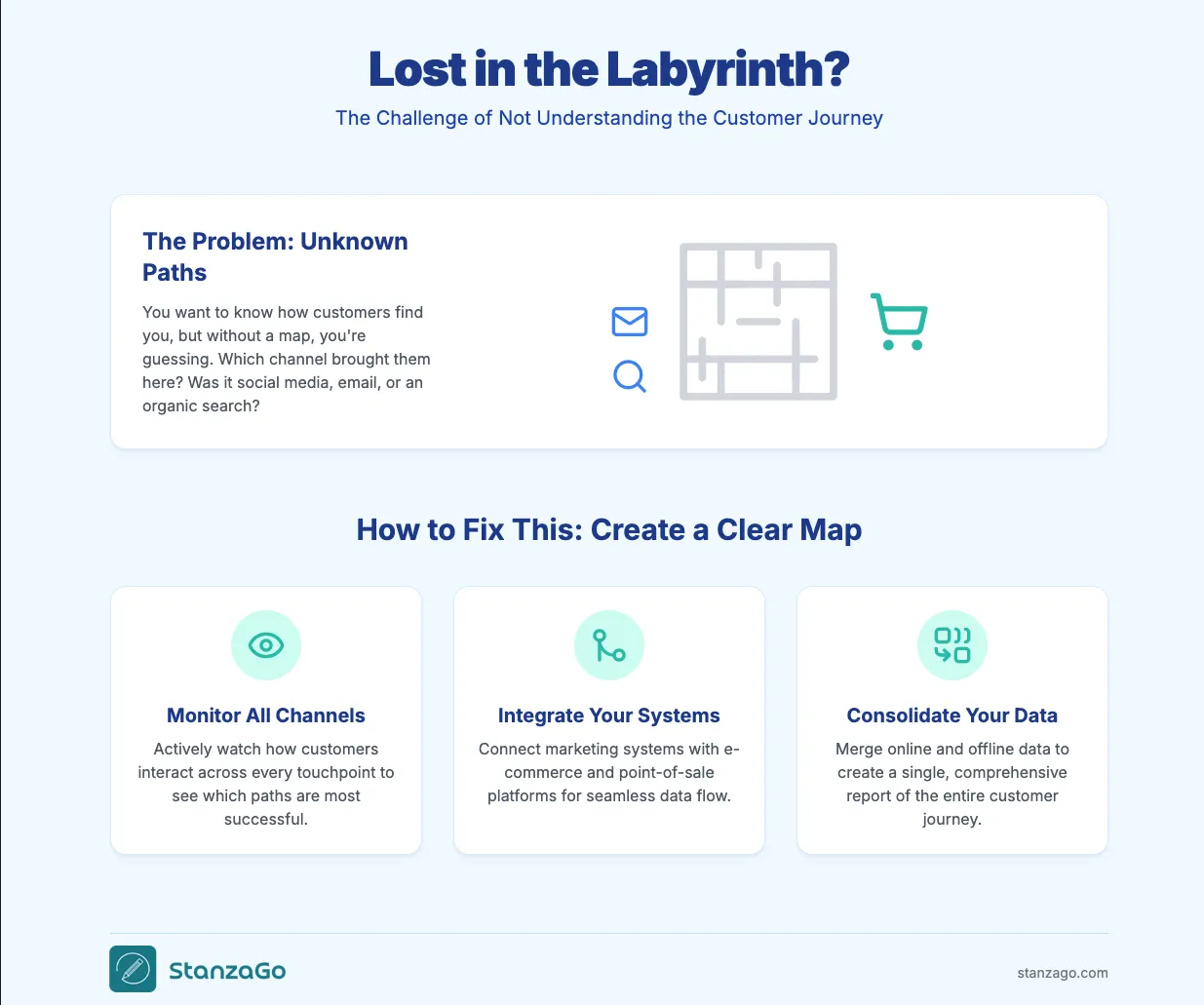
Therefore, it is crucial to understand whether they learned about your brand on social media, website, poster, email, organic search, paid search, or any other channel.
With that knowledge, it becomes easier to know which channel is most successful.
How to Fix This Challenge
Monitor the different channels to know how best to gain customers who then take action on your website or even perform a certain action.
That data can go a long way in ensuring the prosperity of your business.
All companies need to look for marketing systems that can integrate with point of sale and e-commerce platforms for easy data accessibility. Also, the online and offline data should be consolidated to get a good end report.
Practical Omnichannel Marketing Example
There are different existing brands making good use of omnichannel marketing strategies. Let's say you have an e-commerce website where you sell different kinds of electronics.
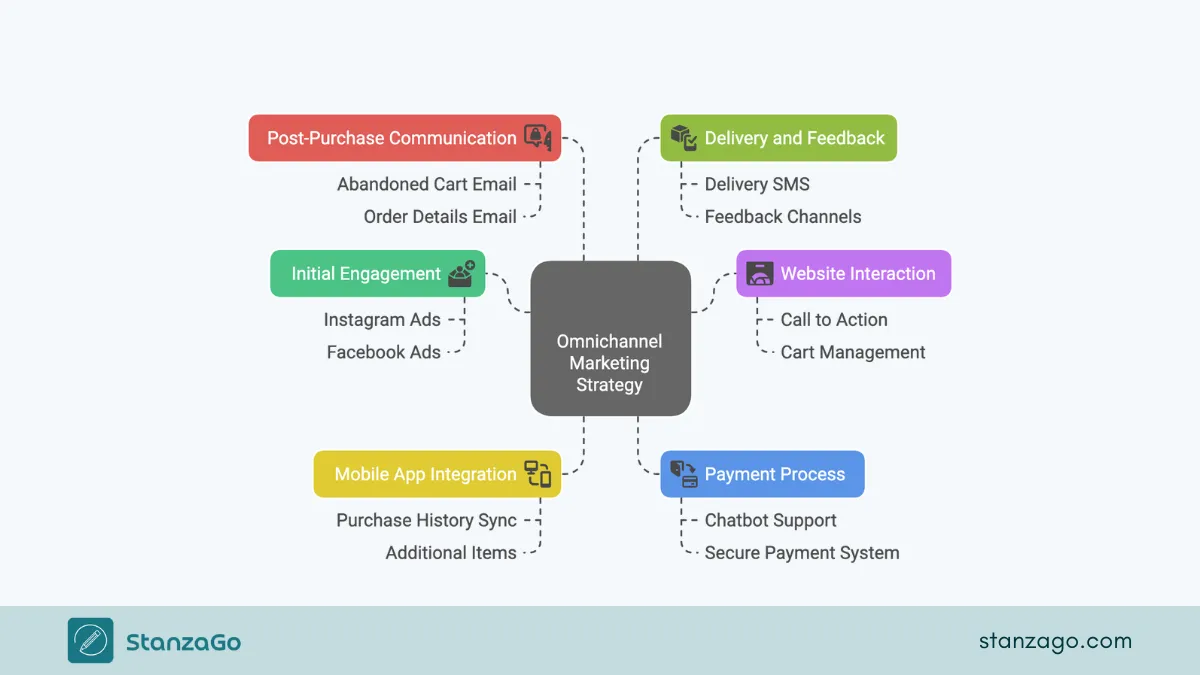
Step 1: A consumer sees an ad on Instagram or Facebook and is redirected to your online store.
Step 2: While browsing the website, they get items they prefer. Therefore, a consumer adds an item to the cart, and a prompt appears: "Would you like to continue shopping?" That's a Call to Action.
Step 3: The consumer continues to make more purchases and adds to the cart. However, before finishing the purchase, they get disrupted and opt to use the mobile app to add more items to the cart.
The purchase history on the website is the same as the one on the app.
Step 4: They decide to pay for the items added to the cart.
However, they are not sure of how to go about it and access the chatbot that answers any inquiry he/she has about the payment system. The consumer then decides to add the credit information due to the security of the payment system.
Step 5: If they abandon the cart, they will get an email, reminding them of the pending cart, and in case they proceed with the purchase, they get an email with the order details, purchase terms, tracking code, and expected delivery date.
In case of any questions, they can get in touch.
Step 6: When the delivery is about to reach the user, they get an SMS on the item arriving or a phone call from the delivery person.
Step 7: The item can come with the online store’s branding, with contact information. Once done, the customer can review the item and provide information on how the service was through the app, SMS, website, or email.
Different channels have been used to communicate with the user. The website, call-to-action button, chatbot, prompt, SMS, phone, branding, email, and payment system integration.
That's what we refer to as omnichannel marketing.
If the consumer opts into regular item updates, they will always get email notifications. All the channels are seamlessly integrated. The same account information found on the website should be readily present in the online store's app.
What's the Difference Between Multichannel Marketing and Omnichannel Marketing?
Multichannel marketing is the use of different media to reach potential customers, for example, through social media platforms, websites, email, and much more. Information on the different platforms may not be directly connected, even when representing a certain brand.
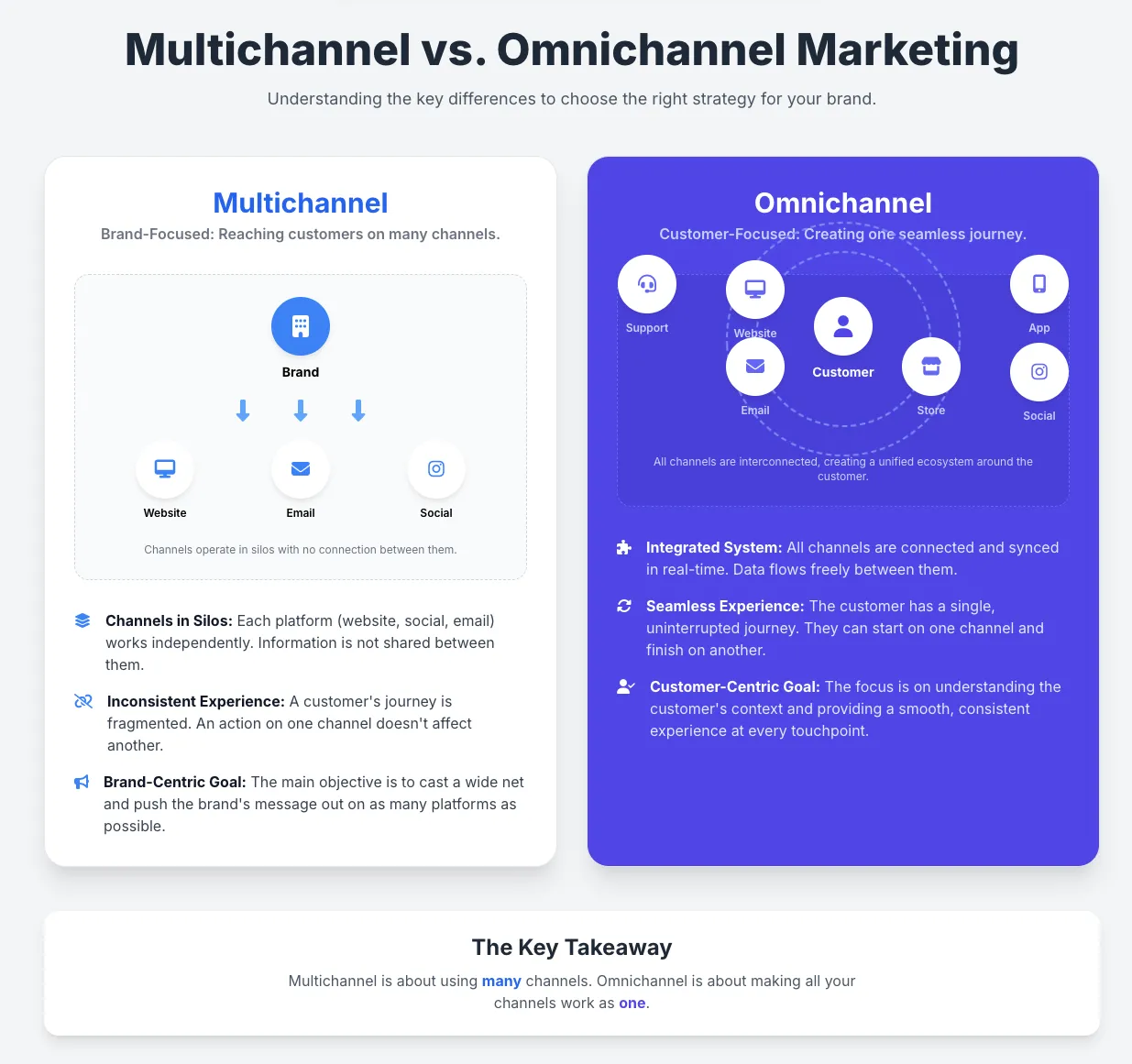
On the other hand, omnichannel marketing refers to the integrated and seamless use of the different channels within and between them. It's like an uninterrupted mode of marketing from the beginning to the end.
For example, a customer sees the item ad on Facebook and decides to click the ad to access the item and purchase it on Amazon. It is a straightforward process. Once they sign up and make the purchase, they will get future updates on similar products.
Therefore, with omnichannel, the user interacts in the different channels with the same motive.
They can even check their purchase history to see what items they purchased and would want to re-purchase. Therefore, it is important to understand the multichannel and omnichannel strategies to see what will work best for you.
Benefits of the Omnichannel Marketing
From many, there are primarily six benefits of omnichannel marketing.
- Consumers get a personalized experience.
- All the information provided is the same on the website, app, and other media.
- Consumers get a seamless experience.
- The consumer gets personalized recommendations and suggestions based on preference.
- Use of different integrated channels to acquire, engage, and retain customers.
- Easy coordination in the marketing team.

- Step-by-step, SEO-driven guides
- Keyword-rich & easy to read
- Clear structure for better engagement
FAQs - Frequently Asked Questions
1. What is a common issue for companies using omnichannel marketing?
A common issue for companies using omnichannel marketing is finding a reliable platform. Often, especially for small businesses, implementing omnichannel marketing on a limited budget can be tiresome.
2. How effective is omnichannel marketing?
If done correctly, you can expect a 287% increase in sales, all thanks to omnichannel marketing. Source: Wisernotify omnichannel statistics and trends 2025.
3. What is the trend in Omnichannel marketing?
Personalization and capturing user attention through AI are the primary trends of Omnichannel marketing. Short-form content and user pain point-driven solutions can help you effectively do omnichannel marketing.
Prosper In Your Omnichannel Marketing (Conclusion)
According to Forbes, omnichannel campaigns can lead to 287% more purchases than when using a single-channel campaign. Omnichannel marketing can help you grow tremendously in your company or startup.
However, understanding your customers or potential customers is key to providing the perfect experience.
Therefore, the marketing or technical team needs to coordinate the different processes to ensure the same information is provided in the different channels to meet the enterprise's demands. Data is key, and regular updates of data can help solve many issues that occur.
Thus, a well-designed strategy with the right goals in mind will help solve the issues.
These challenges of omnichannel marketing need to be fixed for the prosperity of any company.



